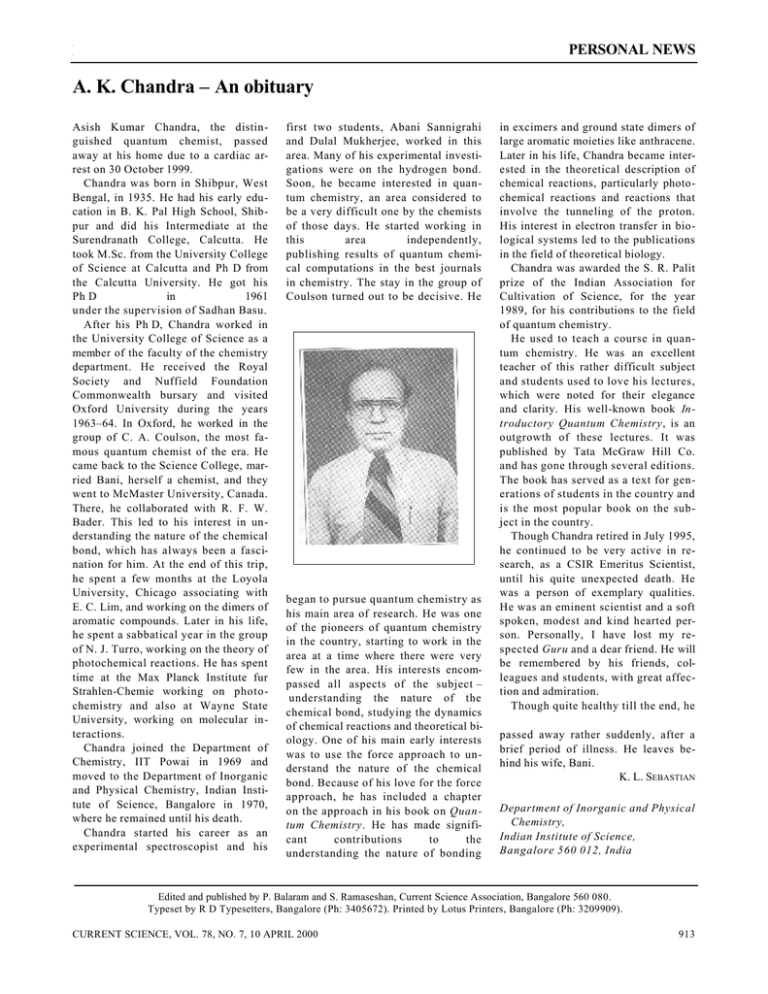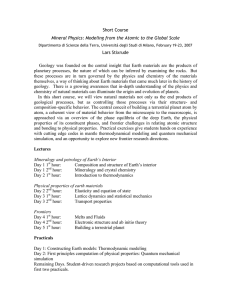A. K. Chandra – An obituary P
advertisement

PERSONAL NEWS P A. K. Chandra – An obituary Asish Kumar Chandra, the distinguished quantum chemist, passed away at his home due to a cardiac arrest on 30 October 1999. Chandra was born in Shibpur, West Bengal, in 1935. He had his early education in B. K. Pal High School, Shibpur and did his Intermediate at the Surendranath College, Calcutta. He took M.Sc. from the University College of Science at Calcutta and Ph D from the Calcutta University. He got his Ph D in 1961 under the supervision of Sadhan Basu. After his Ph D, Chandra worked in the University College of Science as a member of the faculty of the chemistry department. He received the Royal Society and Nuffield Foundation Commonwealth bursary and visited Oxford University during the years 1963–64. In Oxford, he worked in the group of C. A. Coulson, the most famous quantum chemist of the era. He came back to the Science College, married Bani, herself a chemist, and they went to McMaster University, Canada. There, he collaborated with R. F. W. Bader. This led to his interest in understanding the nature of the chemical bond, which has always been a fascination for him. At the end of this trip, he spent a few months at the Loyola University, Chicago associating with E. C. Lim, and working on the dimers of aromatic compounds. Later in his life, he spent a sabbatical year in the group of N. J. Turro, working on the theory of photochemical reactions. He has spent time at the Max Planck Institute fur Strahlen-Chemie working on photochemistry and also at Wayne State University, working on molecular interactions. Chandra joined the Department of Chemistry, IIT Powai in 1969 and moved to the Department of Inorganic and Physical Chemistry, Indian Institute of Science, Bangalore in 1970, where he remained until his death. Chandra started his career as an experimental spectroscopist and his first two students, Abani Sannigrahi and Dulal Mukherjee, worked in this area. Many of his experimental investigations were on the hydrogen bond. Soon, he became interested in quantum chemistry, an area considered to be a very difficult one by the chemists of those days. He started working in this area independently, publishing results of quantum chemical computations in the best journals in chemistry. The stay in the group of Coulson turned out to be decisive. He began to pursue quantum chemistry as his main area of research. He was one of the pioneers of quantum chemistry in the country, starting to work in the area at a time where there were very few in the area. His interests encompassed all aspects of the subject – understanding the nature of the chemical bond, studying the dynamics of chemical reactions and theoretical biology. One of his main early interests was to use the force approach to understand the nature of the chemical bond. Because of his love for the force approach, he has included a chapter on the approach in his book on Quantum Chemistry. He has made significant contributions to the understanding the nature of bonding in excimers and ground state dimers of large aromatic moieties like anthracene. Later in his life, Chandra became interested in the theoretical description of chemical reactions, particularly photochemical reactions and reactions that involve the tunneling of the proton. His interest in electron transfer in biological systems led to the publications in the field of theoretical biology. Chandra was awarded the S. R. Palit prize of the Indian Association for Cultivation of Science, for the year 1989, for his contributions to the field of quantum chemistry. He used to teach a course in quantum chemistry. He was an excellent teacher of this rather difficult subject and students used to love his lectures, which were noted for their elegance and clarity. His well-known book Introductory Quantum Chemistry, is an outgrowth of these lectures. It was published by Tata McGraw Hill Co. and has gone through several editions. The book has served as a text for generations of students in the country and is the most popular book on the subject in the country. Though Chandra retired in July 1995, he continued to be very active in research, as a CSIR Emeritus Scientist, until his quite unexpected death. He was a person of exemplary qualities. He was an eminent scientist and a soft spoken, modest and kind hearted person. Personally, I have lost my respected Guru and a dear friend. He will be remembered by his friends, colleagues and students, with great affection and admiration. Though quite healthy till the end, he passed away rather suddenly, after a brief period of illness. He leaves behind his wife, Bani. K. L. SEBASTIAN Department of Inorganic and Physical Chemistry, Indian Institute of Science, Bangalore 560 012, India Edited and published by P. Balaram and S. Ramaseshan, Current Science Association, Bangalore 560 080. Typeset by R D Typesetters, Bangalore (Ph: 3405672). Printed by Lotus Printers, Bangalore (Ph: 3209909). CURRENT SCIENCE, VOL. 78, NO. 7, 10 APRIL 2000 913


